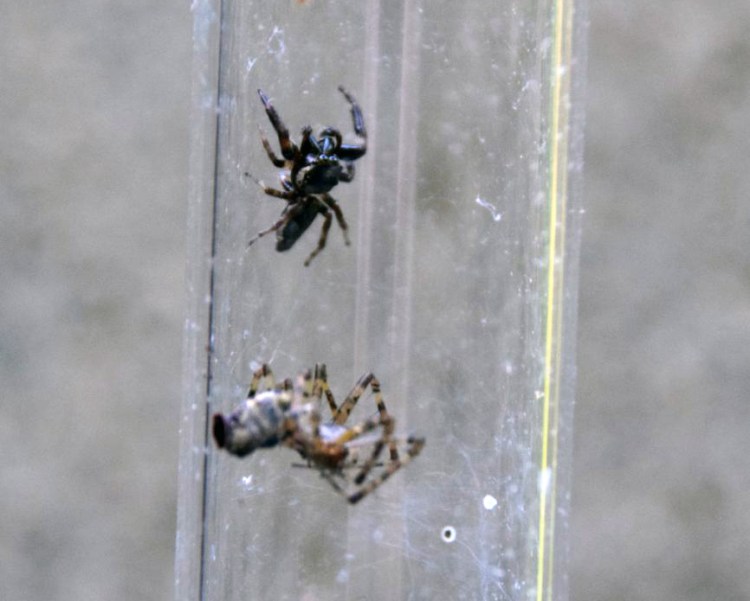For a backyard amateur, I’ve gotten pretty good at herding small creatures neatly into glass vials to keep and watch. Not wanting to harm them, I always let them go after a day or two.
At the Unity park recently I captured a hammock spider, a species of sheetweb weaver. They build sheetlike webs, often with lines of silk strung overhead to knock flying insects onto the sheet. They hang upside down underneath the sheet, and when vibrations in the web tell them something’s caught, they open a hole and pull the prey item down through, paralyze it with a bite, and then, at some point, eat it. Many sheetweb weavers go back and repair the hole.
Anyway, I spotted this spider hanging under her web, got out my little glass vial, and after a few seconds of spider-herding, sealed her in with the cork stopper. Through my pocket magnifying glass I saw the markings of, most likely, a hammock spider. Close enough for jazz, as we used to say of guitar-tuning in the rock-‘n’-roll band. I put the vial and the spider in my pocket to check on later.
When I got home and was just shutting the car door, something moved on the hood. It had the gait of a spider — run a few steps, stop to look around, run a few more steps, pause, delicate, walk a few steps — unlike ants, which are in almost perpetual zigzag motion. Its big front eyes indicated it was a jumping spider. I only had the one vial, which already contained the hammock spider. Maybe I could herd the jumping spider in there before the sheetweb weaver ran out.
I fished the vial out of my pocket. As luck would have it — for me, at least — the sheetweb weaver was busy spinning some fine threads for what might be a retreat near the glass bottom. So I uncorked the vial, aimed carefully, and set it over the jumper, flush to the hood. Now the trick was to get the cork back on without jamming the jumping spider’s legs, or worse, letting him escape.
More good luck. He ran toward the inside of the vial. So the cork slipped neatly on, spider’s legs in no danger. I congratulated myself on my civilized respect for tiny life.
Inside the vial, though, was another world of monsters, dreams and discord.
The hammock spider immediately ran at the jumping spider. They boxed for a second then ran to opposite ends of the vial. In the next little while, the jumping spider explored the cork end of the vial while the hammock spider worked silk in the glass end. From time to time the hammock spider appeared to forget the situation and wandered toward the jumper. She would suddenly halt, seem to stare for a moment like the proverbial spider in the headlights, then scamper back to the glass end.
When I looked through the magnifying lens, the jumping spider appeared to be a male Eris militaris, aka bronze jumper, common in these parts. (Although this is some very loose jazz, here — jumping spiders are notoriously difficult to ID to species.) Anyway, the standoff inside the vial continued. This probably was not going to end well for one of the spiders. The main reason spider silk — which has some of the most remarkable properties of any natural fiber — is not industrially farmed by humans is that spiders in concentrations sufficient to produce enough silk eat each other. Would the jumping spider eat the sheetweb weaver, or the other way around? Or neither?
My attention wandered to a Doors album that has been seething my savage breast lately. Awhile later, Bonnie asked what my new spiders were doing (hoping I had put the tiny monsters outside, I’m sure). As I started to describe their so-far peaceful co-existence, I checked the vial and saw they were face to face in the middle.
There were feints, lunges, backings off. Then suddenly they were grappling. Long jointed legs furiously pumping.
The struggle went on for maybe 15 or 20 seconds. Then the wrestling stopped. They seemed to have jammed their faces together. For several minutes it was not clear that either one of them had prevailed. The jumping spider adjusted its legs as if to get a better grip. The hammock spider seemed to be trying futilely to work the jumping spider. Within a couple of minutes, the hammock spider’s longer, spindlier legs were markedly less motile. As you would expect of paralyzing poison, soon they were not moving at all. The jumping spider used a few threads of silk to tie off any remaining resistance, then retreated to his end of the vial.
Along about lunchtime, Bonnie asked if anything was left of the hammock spider. With the Doors jazzing in the background, I checked, and the jumping spider was positioned face-first at the hammock spider’s abdomen. He’d sunk his chelicerae in, and was now injecting digestive juices and sucking out the meal. I think behind the veil the hammock spider was probably still alive at that point.
We had a nice chicken salad for lunch.
Dana Wilde lives in Troy. You can contact him at naturalist1@dwildepress.net. His recent book is “Summer to Fall: Notes and Numina from the Maine Woods” available from North Country Press. Backyard Naturalist appears the second and fourth Thursdays each month.
Send questions/comments to the editors.



Comments are no longer available on this story